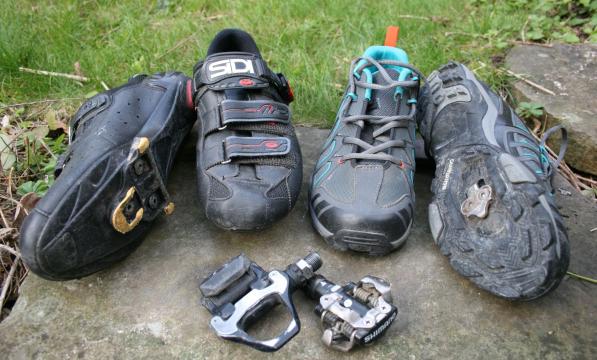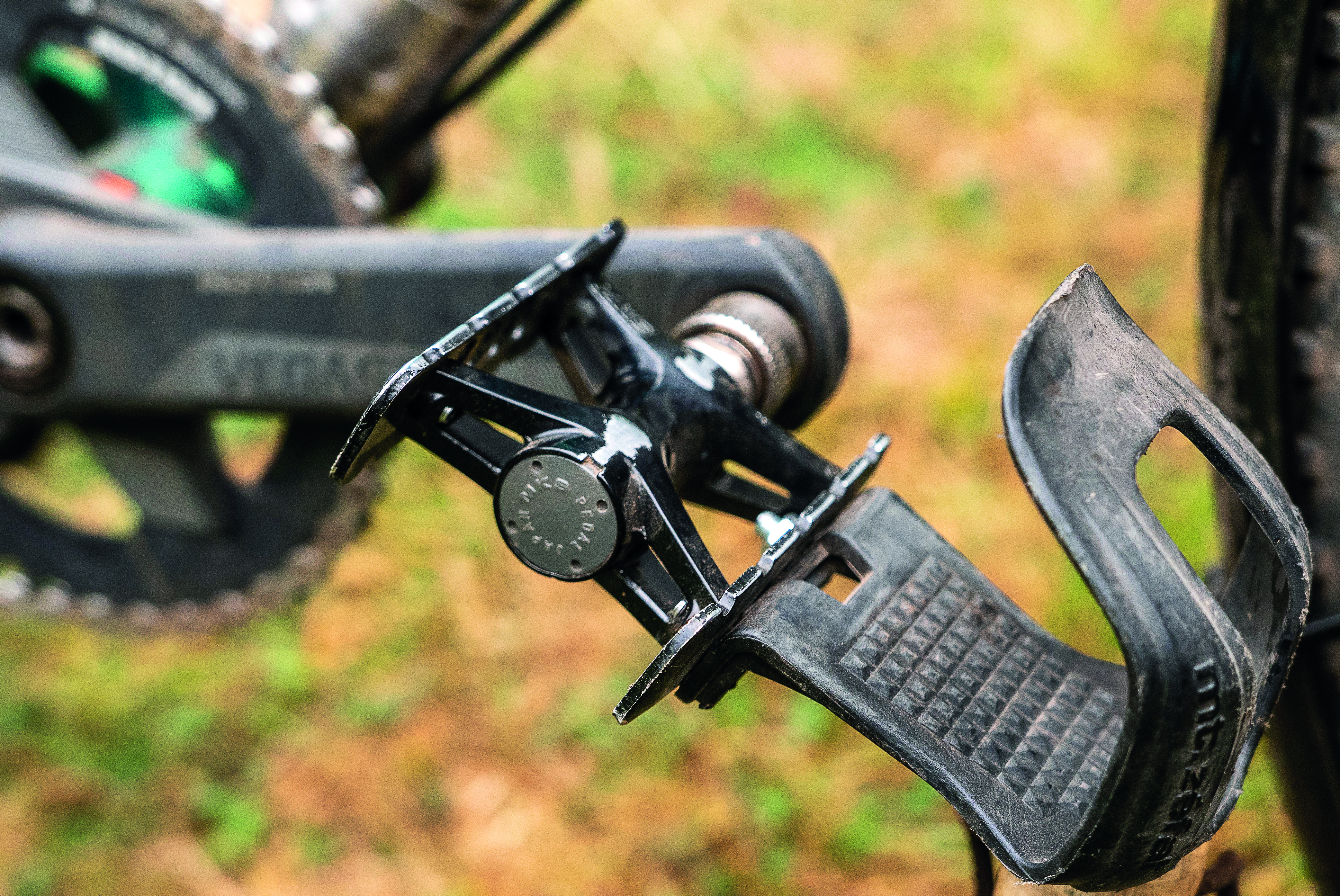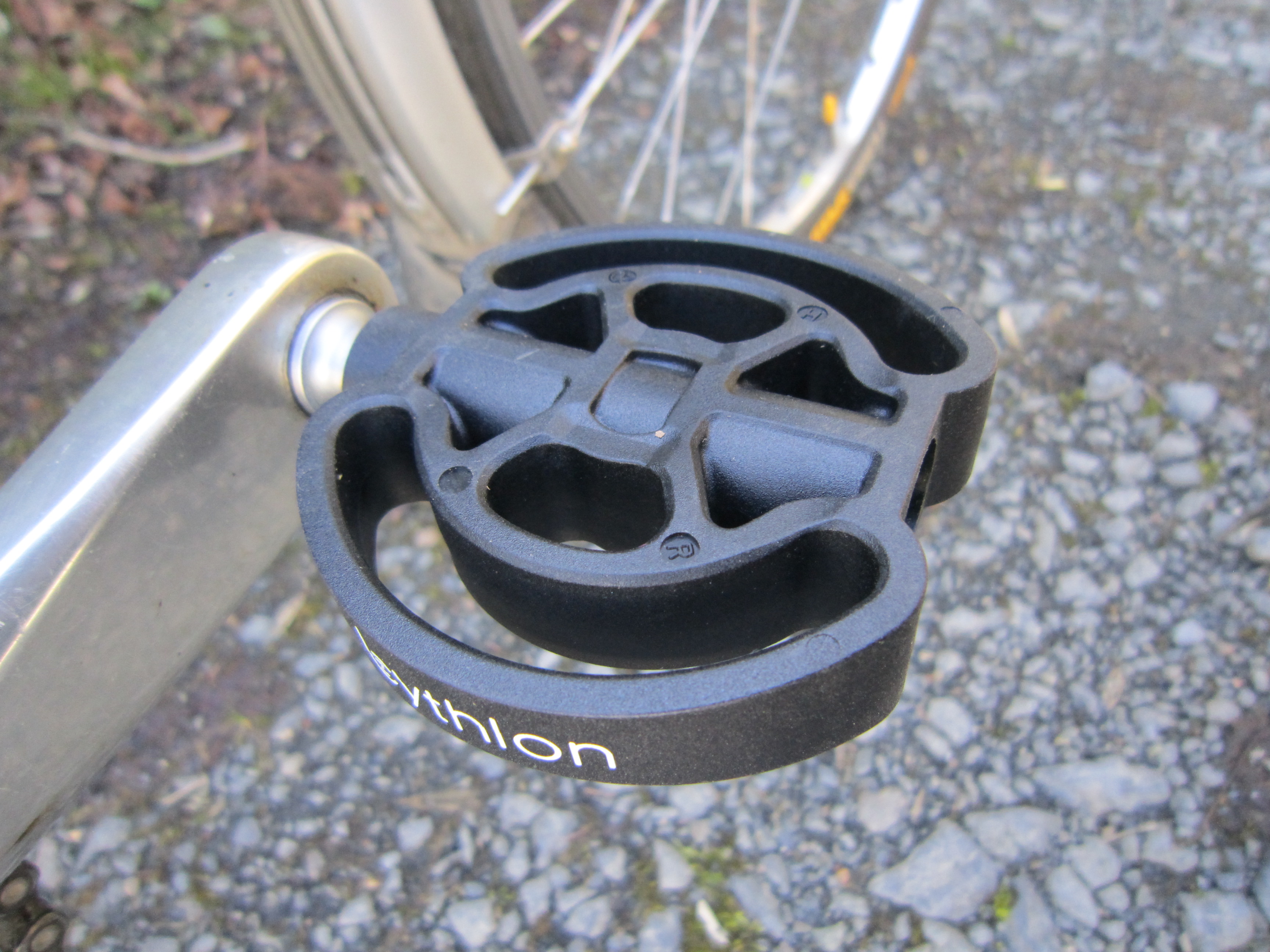Guide to clipless pedals and cleats

What are clipless pedals?
Simply put these are pedals that attach to your shoes. A mechanism on the pedal clips in to a cleat which is fitted to the sole of your shoe. The shoes are specific to the type of pedal.
Having your foot fixed to the pedal like this means better power transfer to the bike. Think of pedalling smoothly in circles, rather than simply pushing down.
Because you’re moving the pedal all the way round, on the way up as well as down, you go faster for less work. No energy is wasted, and your feet never slip. Hill climbing becomes easier. It’s like having a light permanent tailwind.
But why are they called ‘clipless’?
Confusingly, riders talk about being ‘clipped in’ when using so-called ‘clipless’ pedals. It’s because the technology came in for racing cyclists during the 1980s to replace toeclips (adjustable straps that keep the foot in place on the pedal). The tag of ‘clipless’ stuck.
How do they work?
You push your shoe down and slightly forward on to the pedal, and the cleat clicks onto it. To unclip, you twist or pull your foot, depending on the type, and the cleat disengages instantly from the pedal.
Isn’t it tricky to learn?
Most people get the hang of it pretty quickly, in days or even hours. Like depressing a clutch pedal to change gear in a car, it soon becomes natural and unconscious.
How do I start?
Find a wall to lean against, or use a turbo trainer, and practise clipping in and out. For most types of pedals, it’s a simple matter of pushing your foot into the cleat to clip in, and turning your heel quickly outwards to clip out.
Tips
- Some pedal types have multi-direction release, meaning you can pull your foot up sharply to unclip, as well as the standard heel twist.
- If you’ve used traditional toeclips, the action’s not that different, but it’s a twist-and-out rather than a reverse-out.
- Most people take a tumble or two while learning, so after you’ve got the basic technique from leaning against a wall, do a few circuits on soft grass before going out on tarmac.
- Whatever pedals you are using, start by loosening off the tension on the pedal to make it as easy as possible to disengage your foot.
- Most people fall because they don’t think about unclipping until they’re stationary. So, practise unclipping as you prepare to stop, not after!
- In the UK, it’s best to unclip the left foot first as you come to a halt. That way, if you do slip or fall, you don’t do it into traffic. Once unclipped with your left foot on the ground, you can unclip your right. Practise riding slowly, clipping in both feet then unclipping as you come to a halt.


What will it cost?
A basic set of pedals starts around £30. Basic cycling shoes cost from about £60. You can pay more for higher quality or extra features. For instance, some shoes have Gore-Tex lining to keep your feet dry. Others have stiffer soles and fancy ratchet strap systems to hold your feet even more securely.
What types of pedals and shoes are best for me?
It depends on your type of cycling (commuting, racing, mountain biking, touring, and so on). Your local bike shop will be able to advise.
- For mountain bikers, double-sided Shimano SPDs (or similar) are a safe bet. Recessed cleats mean you can walk comfortably, and the small, light platforms are easy to clip in and out of.
- For commuters and tourers, single-sided Shimano SPDs (or similar) are a good option. The flat conventional side works with everyday shoes for short trips, while the other side works with cleats.
- For racing, sportives or club runs, three-bolt Shimano SPD SLs (or similar) offer a broader contact area on the pedal, which is more comfortable on the feet for long rides. Clacky cleats are not too comfy for walking round in, though.
There are two main types of cleat system: recessed, where the cleat is smaller and recessed in the shoe (secured to the shoe by two bolts); and non-recessed, where the cleat stands proud of the shoe (usually three bolts).
Recessed
Recessed cleats are a good starting point. They let you use shoes with flatter soles you can walk in easily – good for general cycling, commuting and touring. They can also be a little easier to unclip, and some allow more movement of the foot on the pedal when clipped in. This lateral movement is called ‘float’. Pedals often have mechanism on both sides, making it easier to clip in.
Shimano’s recessed cleat system is called SPD. This system hasn’t changed in years, and many other manufacturers offer SPD-compatible pedals, so the range is large.
Non-recessed
Non-recessed cleats are more typically used by road cyclists. The large cleat allows for a better connection with the pedal and, when used with stiff-soled shoes, allows for more power transfer. The pedals are often single sided, though, so it’s trickier if you’re learning – there’s an extra knack to getting the pedal the right way up. The pedals also have less float, so your feet are held in a more rigid position. This can cause issues with comfort and other problems if your riding position is not set up correctly; they’re also harder to walk in. Shimano’s non-recessed cleat system is called SPD SL. There are many other types, though, (from brands such as Look, Time, and Speedplay) each with their own proprietary cleat/pedal systems.
- Recessed cleats are better for beginners. They also don’t clack on hard floors like stiletto heels, as non-recessed cleats do.
- Non-recessed cleats are better for serious racers and club riders.
- Make sure the shoes feel comfortable. Try several pairs at your local bike shop.

What sort of pedal should I buy?
There’s a range of types. Some Shimano pedals are quite small. Others offer a larger platform around the clip mechanism. Some are flat on one side and clip in on the other side (‘single sided’).
Some are light action, meaning it’s easier to unclip. This might help if you’re an anxious learner, but most actions are fine once you’re used to them.
- Some pedals, such as Shimano’s Click’R T400, are particularly easy to clip out of, and make things convenient for learners.
- Single-sided pedals give you the option of riding in everyday shoes on the flat side, or in your cycling shoes clipped in on the other side. Such pedals are a good choice if you often use your bike for short utility trips where you don’t want to change into cycling shoes, and where you’d be constantly stopping and starting.
Tweaking your set-up
The cleat can be fixed to the shoes in various positions. There’ll be trial and error to get the most comfortable for you. Try a few short rides and adjust as necessary. Start in a neutral position with the cleat below the ball of your foot. Take a look at where your feet naturally sit when on the pedals – you may need to rotate the cleat to accommodate.
- Cleat position might be slightly different for each foot.
- Cleats can change the height of your foot on the pedal, so you might have to adjust the saddle height to compensate.
Am I too old to go clipless?
Plenty of riders in their 60s and even 70s switch to clipless happily. Picking up the foot technique isn’t a problem, but you will fall off a few times while learning. For some less robust physiques that could be an issue.
Does it work for everyone?
For the great majority, yes. On a typical club leisure ride, more than 90% will be using clipless pedals. But, as with contact lenses, a few people just don’t take to them.
Is it worth it?
If you’re strictly a round-town cyclist, trail family trundler, short-hop commuter or occasional-only rider, there’s little to be gained by going clipless. But if you regularly pedal more than say five minutes without a halt, whether touring, commuting, or on longer pleasure or utility rides – or if you ever go up hills – you’ll very probably be glad you changed.
Sure, it’s a faff choosing the right shoes and pedals. It takes a few days to get the knack of clipping in and out. And it costs money. But for most cyclists who change, going clipless improves their comfort, pedalling style and efficiency, and they never switch back.







